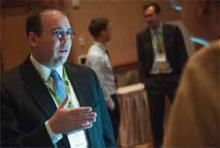Quality Improvement, Patient Safety Top Hospitalists’ Priority Lists at HM14
LAS VEGAS—Hospitalist Ijeoma “Carol” Nwelue, MD, has been more focused on patient readmissions over the past year at her practice in Lansing, Mich. So when the directors at Sparrow Hospitalists told her she had a meeting a few weeks after HM14 to discuss different risk assessment tools that might be used to pre-identify patients at high risk for readmission, she wasn’t nervous.
Instead, she prepped at SHM’s annual meeting at Mandalay Bay Resort and Casino—a veritable three-day crash course in the latest and greatest approaches to preventing readmissions.
“It’s very helpful,” she says. “It helps to see things that I haven’t thought about in our practice that other people are looking into.”
Quality improvement (QI) and patient safety are at the core of what hospitalists do, and the HM14 organizers understand that. From multiple pre-courses on the topics trending today to a dedicated educational track of breakout sessions and expert speakers to hundreds of posters identifying HM-specific QI projects, SHM’s annual meeting is a veritable QI opportunity of its own.
Take the annual pre-course, “ABIM Maintenance of Certification Facilitated Modules.” One attendee told presenter Read Pierce, MD, director of quality improvement and clinical innovation for the hospitalist group at the University of Colorado Denver, that before the session in Las Vegas he had always had “the sense that quality and safety is soft science or fuzzy stuff around the edges, and if you were a smart clinician, that was good enough.”
After some time in the session, Dr. Pierce recounts, the man “realized it’s not just enough to have great intellectual horsepower. You have to have some approach for dealing with these complex systems. And I think that’s the really fun thing….It’s not just about the discreet concepts; it’s about understanding the environment in which we practice, the importance of engaging systems and of using the tools of quality and safety to augment what physicians have always been good at doing.”
John Coppes, MD, FHM, a hospitalist at Mount Nittany Medical Center in State College, Pa., says quality and patient safety are the “most important things that we do.”
“It’s our responsibility to our patients to do the best job we can,” he notes. “It’s our responsibility to society to do it as efficiently as we can.”
Veteran meeting faculty John Bulger, DO, MBA, FACP, SFHM, hospitalist and chief quality officer at Geisinger Health System in Pennsylvania, agrees completely and is one of HM’s biggest proponents of the American Board of Internal Medicine (ABIM) Foundation’s Choosing Wisely (www.hospitalmedicine.org/choosingwisely) campaign. The national initiative, aimed at educating physicians—and patients—about wasteful medical tests, procedures, and treatments, launched in 2012, but SHM joined the chorus as a strategic partner last year.
“Choosing Wisely is about bending the cost curve,” Dr. Bulger says.
He added that although standardization of care is necessary for Choosing Wisely to work, homogeneity doesn’t mean everybody does everything exactly the same way. It means ensuring that hospitalists adopt “agreed upon best practices” before local variations are added. He compared it to a cookbook of apple pie recipes. All apple pies contain apples and crust, but the tasty treats are tailored differently from there.
“When you come up with guidelines in your hospital, that’s what you’re doing,” Dr. Bulger says. “You’re writing the cookbook and coming up with what works at your hospital. It might not work at [my hospital] at all, but I can look at it and learn.”





